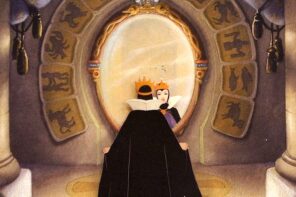“I need to be good because of the elf that lives my room,” my five-year old explained.
“The what? Who lives where?” I ask.
“The elf that knows if I’m bad or good,” she replies.
“There is no elf in your room,” I say.
“Yes, there is. He’s invisible,” she notes.
I sigh wearily.
I lost this argument, much like other Christmas-related debates in our household. When I told her that Santa can’t fulfill every gift on her list, she declared that “he’s magic” as if that explained all. (For the record, I didn’t introduce her to Santa, but everyone around us did. His twinkling eyes and red suit are completely unavoidable.)
While I have mostly come to terms with her affectionate attachment to Santa, the elf added a new wrinkle to Santa’s involvement in our family life.
Her imaginary elf is a version of The Elf on the Shelf ™, an androgynous, rosy-cheeked elf toy that monitors children as Christmas approaches. It is available in light or dark-skinned varieties. Accessories allow families to transform the elf into a boy or girl.
The elf emerged from The Elf on the Shelf: A Christmas Tradition co-authored by mother and daughter, Carol Aebersold and Chanda Bell. The book alone has sold over six million copies since it was released in 2005. For $29.95, parents can purchase the book and toy to start a new tradition. The story presents a “scout elf,” who journeyed all the way from the North Pole to watch children to find out whether they are naughty or nice. The elf surveils children during the day to uncover bad behavior, then it returns to the North Pole every night to report back to jolly old St. Nick.
There are two rules that govern children’s interaction with their elf. First, the elf is magic, and a child’s touch can compromise its ability to return and report. Its enchantment disappears if a child touches it for any reason. Second, the elf cannot interact with children during the day because its role is to observe and listen. The creators, however, encourage children to talk to their elves—especially to share secrets. The elf can learn more about the children, the more they share. Telling the elf secrets seems to secure a space on the nice list.
These elves are ubiquitous. They can be purchased from bookstores, Target, and online retailers. Tutus can create girl elves, and sports jerseys can masculinize the boy elves. Parents move elves around their homes, so that the elf is a different spot every morning. Some parents elaborately stage elves making mischief with marshmallow fights and flour “snow” angels.
Facebook photos of Santa’s helpers abound as parents document how scout elves act when left to their own devices. The elves do not remain on their shelves for long. We do not own an elf, despite my daughter’s beseeching requests. Her friends have elves in their homes. Her preschool class has multiple elves on a bookshelf that her teacher uses to encourage good behavior. The elves are watching whether I approve or not.
It should be surprising that The Elf on the Shelf fascinates and repels me.
The phenomenon piques my interest because the elves provide material evidence of Santa’s reality. Watching from their shelves in homes, they confirm that Santa exists. Their materiality makes his magic plausible. Writing on Santa, Nathan Schneider argues that the holiday spirit is mostly based on the irrelevance of proof. Evidence does not matter because Santa. Adults all know that Santa does not exist, yet lying to children about him is cultural expectation. Try explaining to someone, anyone really, that you want to opt of St. Nick for your kids. To put it mildly, it does not go over well. (I might have been accused of child abuse.)
There is no proof of his existence because he doesn’t exist. The fevered attempts of adults make him real. Parents encourage children to write letters to Santa. At malls and shopping centers, girls and boys sit on his lap and tell him all the things that they want. Apps show the existence of elves in your house as proof of the Kris Kringle. Google’s Santa Tracker allows families to follow his global journey with reindeer and sleigh. And now, elves serve as narcs. These practices bolster and foster the belief in Santa’s reality. We need them to convince children and ourselves that the world can still be magical, if only for one night. Belief persists in a known lie.
The Elf of the Shelf ™ troubles me. It seems a bit nefarious in light of the revelations about the NSA’s domestic surveillance program. Somebody is surely watching us, but it is the government, not Santa. Santa and elves fit into our current moment of surveillance and data mining. The classic song “Santa Claus is Coming to Town” illustrates how. Santa is an omnipresent figure who watches children both day and night. “He knows when you are sleeping/He knows when you’re awake.” He emerges as benevolent, only if you weren’t naughty. Be good, the song chides us, be good. Yet, to “be good for goodness’s sake” was always already to be good just for Christmas’s sake. Goodness only mattered because gifts could be in peril.
While the creepy undertone of the song might bother me, the elves take this a step further. Families invite the elves into their homes for the explicit purpose of monitoring children. Yes, this might ensure good behavior between Thanksgiving and Christmas (child psychologists worry about what happens when parents farm out discipline to Santa). More importantly, these elves teach children that they should expect to be watched even in their own homes.
This expectedness of being watched disconcerts me. Surveillance is now a part of childhood with video cameras everywhere; monitoring every action in fear of catastrophe, especially in schools. The goal is to see everything. Hypervisibility becomes expected and naturalized. All things must be seen. The panopticon is here. The space of childhood is also the haven of things unseen, magic, enchantment, and endless possibility. Monsters could exist under your bed. Santa can deliver gifts to all children in only one night. And now, magical elves can report your naughtiness, so you better be nice. Surveillance is a dominant force in our world, so why wouldn’t Santa be implicated? Santa and his helpers seem to make the erosion of privacy comfortable and normal. In the name of family tradition and good behavior, what does The Elf on the Shelf ™ teach our children? Someone’s always watching, so act accordingly.




